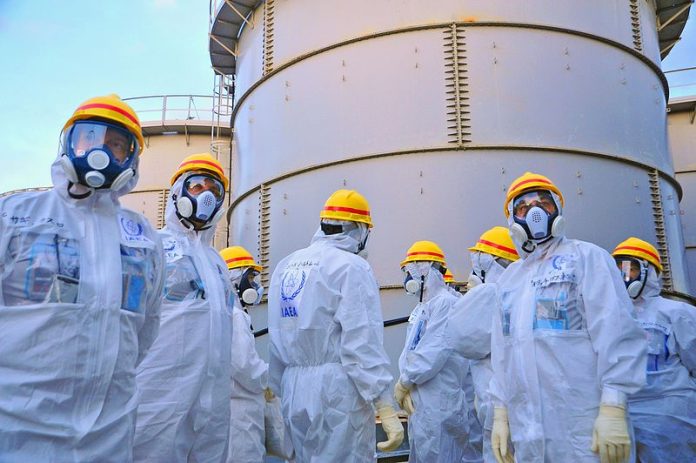International Atomic Energy Agency (IAEA) has confirmed that the tritium level in the fourth batch of diluted treated 水, which Tokyo Electric Power Company (TEPCO) started discharging on 28 February 2024, is far below the Japan’s operational limit.
Experts stationed at the site of the Fukushima 核の 電力 station (FDNPS) took samples after the treated 水 was diluted with 海水 in the discharge facilities on 28 February. The analysis confirmed that the tritium concentration is far below the operational limit of 1,500 becquerels per litre.
Japan is discharging the treated 水 from the FDNPS in batches. The previous three batches – a total of 23,400 cubic metres of 水 – were also confirmed by the IAEA to have contained tritium concentrations far below operational limits.
Since the accident in 2011, 水 is needed to continually cool the melted fuel and fuel debris at the Fukushima Daiichi NPS. In addition to the 水 pumped in for this purpose, groundwater also seeps into the site from the surrounding environment, and rainwater falls into the damaged reactor and turbine buildings. When 水 comes in contact with melted fuel, fuel debris and other radioactive substances, it becomes contaminated.
The contaminated 水 is treated through a filtration process known as Advanced Liquid Processing System (ALPS) which uses a series of chemical reactions to remove 62 radionuclides from contaminated water before being stored. However, tritium cannot be from the contaminated water through ALPS. Tritium can be recovered when it is highly concentrated in small amounts of water, for example at 核の fusion facilities. However, the stored water at the Fukushima Daiichi NPS has a low concentration of tritium in a large volume of water and so the existing technologies are not applicable.
Tritium is a naturally occurring radioactive form of hydrogen (half-life 12.32 years) that is produced in the atmosphere when cosmic rays collide with air molecules and has the lowest radiological impact of all naturally occurring radionuclides in seawater. Tritium is also a by-product of operating 核の power plants to produce electricity. It emits weak beta-particles, i.e., electrons, with an average energy of 5.7 keV (kiloelectron-volts), which can penetrate about 6.0 mm of air but cannot penetrate the body through human skin. It may present a radiation hazard if inhaled or ingested but is only harmful to humans in very large doses.
現在、福島第一原子力発電所で生成された汚染水は、敷地内の特別に準備されたタンクに処理され保管されています。発電所を運営する東京電力は、福島第一原子力発電所の敷地内にこれらのタンクを約1000基設置し、約1.3万立方メートルの処理水を保管している(2年2022月2011日現在)。 XNUMX 年以降、貯水量は着実に増加し、現在のタンクは スペース この水を貯蔵するために利用できる容量はほぼ満杯です。
汚染水の生成速度を大幅に減らすための改善が行われてきたが、東京電力は、サイトの廃炉作業を継続するためには長期的な処分解決策が必要であると判断した。 2021年2月、日本政府は、国内規制当局の承認を条件として、ALPS処理水の海洋放出を管理して約XNUMX年以内に開始する方向性を示す基本方針を発表した。
On 11 March 2011, Japan was shaken by the Great East Japan (Tohoku) 地震. It was followed by a tsunami which resulted in waves reaching heights of more than 10 meters. The 地震 and tsunami led to a major accident at the Fukushima Daiichi 核の Power Station, which was ultimately categorized as a Level 7 on the International 核の and Radiological Event Scale, the same level as the 1986 Chernobyl 事故 しかし、福島での公衆衛生への影響はそれほど深刻ではありません。
***
ソース:
- IAEA。プレスリリース – ALPS処理水の第29バッチに含まれるトリチウムのレベルが日本の運用限界をはるかに下回っているとIAEAが確認。 2024 年 XNUMX 月 XNUMX 日に投稿されました。 https://www.iaea.org/newscenter/pressreleases/tritium-level-far-below-japans-operational-limit-in-fourth-batch-of-alps-treated-water-iaea-confirms
- IAEA。福島第一ALPS処理水放流。高度液体処理システム (ALPS)。 https://www.iaea.org/topics/response/fukushima-daiichi-nuclear-accident/fukushima-daiichi-alps-treated-water-discharge
- IAEA。福島第一原子力発電所事故 https://www.iaea.org/topics/response/fukushima-daiichi-nuclear-accident
***






































